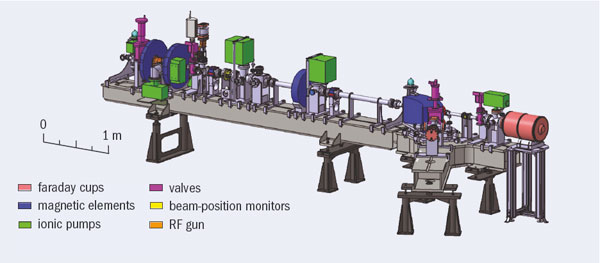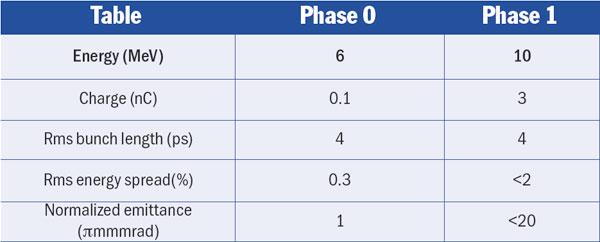A new linac test facility is under construction at the Laboratoire de l’Accélérateur Linéaire (LAL), Orsay. The primary goal of the accelerator, called PHIL, is for testing photo-injection as part of research and development of advanced RF guns. The size of the machine is modest in comparison with the Photo Injector Test Facility at DESY Zeuthen (PITZ) or the CLIC Test Facility (CTF3) at CERN. However, PHIL will also be used to train students and engineers, and the facility will be open to physics experiments that need low-energy, well-defined electron beams for detector calibration.

As civil engineering was required to reinforce the existing shielding to comply with current radiation safety requirements, the machine has been delayed and is now being constructed in two phases. Phase 0 consists of an RF gun with a copper photocathode, vacuum chambers, pump system, all magnetic elements, a dipole to analyse the energy distribution, and standard instrumentation. It uses a temporary 2.5 cell RF gun fed by a co-axial “doorknob” coupler. This is a copy of the gun constructed by LAL for the ALPHA-X accelerator at the University of Strathclyde in the UK.
For Phase I the laboratory will install a booster to bring the beam energy to 10 MeV and increase the diagnostic facilities. In parallel, a new RF gun will be constructed with a high-efficiency caesium-telluride photocathode prepared in situ in a special vacuum chamber. This will be directly derived from the type IV gun for CTF3.

The photocathodes in the new facility are illuminated by a Nd:YLF picosecond mode-locked laser, which delivers a single pulse at 5 or 10 Hz and is used on the fourth harmonic at 262 nm wavelength. The laser pulse-to-pulse stability is close to 1% for approximately eight hours. The optical path length is approximately 17 m and the laser light is injected at nearly normal incidence on the photocathode. Different spot sizes are obtained by changing the position of the last lens.
The table above summarizes the technical specifications for PHIL; in addition, the RF frequency is 2.998 MHz and the repetition rate limited to 10 Hz. A dedicated area of 20 m2 for physics experiments has been planned at the downstream end of the accelerator.
All the infrastructure, water cooling, cabling, magnetic elements, RF gun, RF network and RF source are now ready and commissioned for Phase 0, and the control room is available and the software is in the process of completion. The main task remaining is the installation of the laser line optics. RF tests and conditioning should take place just after the summer shut down. The French radiation authority (Autorité de sûreté nucléaire) has authorized LAL to produce a first test beam run and, after a radiation control, the laboratory should obtain the permanent authorization for routine operations before the end of the year.





